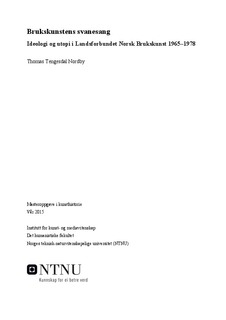| dc.description.abstract | Landsforbundet Norsk Brukskunst hadde siden opprettelsen i 1918 (da som Foreningen Brukskunst) fungert som brukskunstbevegelsens flaggskip og samlende enhet. Forbundets program og ideologi var fundert i modernismens tro på universelle løsninger. Under slagordet «vakrere hverdagsvarer» jobbet forbundet for at det måtte etableres en enhetlig moderne stil innen norsk brukskunst, og hvor den «praktisk brukbare og kunstnerisk vakre» hverdagsvaren måtte gjøres tilgjengelig for det brede lag av befolkningen. Dette arbeidet nådde på mange måter sitt høydepunkt gjennom det fellesnordiske arbeidet med Scandinavian Design på 1950- og 60-tallet. Her ble den nordiske brukskunsten koblet til fortellingen om et felles moderne formspråk, som sprang ut av en enkel og demokratisk nordisk livsform.
Utover 1960- og 70-tallet skjedde det derimot omveltninger i brukskunstmiljøet og samfunnet for øvrig som utfordret og satte press på det etablerte brukskunstregimet. Dette kom bla annet til uttrykk gjennom en økt polarisering mellom kunsthåndverk og industridesign. Gjennom en bredere nyorientering i den nordiske formgivningsmiljøet ble det stilt krav til at formgiveren måtte gjøres samfunnsnyttig, og at det måtte legges større vekt på «virkelige» problemer i samfunnet. Samtidig med dette opplevde man også en interesseforskyvning innad i brukskunstmiljøet, hvor blikket ble løftet fra enkeltgjenstander til miljøer, og hvor samfunnet som helhet fikk større oppmerksomhet.
Gjennom oppgaven blir det gjort rede for hvordan Landsforbundet forholdt seg til endringene i brukskunstmiljøet og samfunnet for øvrig i perioden. Jeg viser hvordan forbundets ledelse forsøke å samle faggruppene om felles mål og arbeidsoppgaver for å motvirke splittelsen i fagmiljøet. I dette ble det argumentert for en utvidelse av brukskunstbegrepet og hvor brukskunstideologien ble forsøkt revitalisert og koblet til det nye samfunnsengasjementet i tiden. Gjennom oppgaven viser jeg hvordan forbundets samlingsprosjektet i liten grad førte fram, og hvordan ledelsens overbevisning om at fagmiljøet måtte stå samlet om felles mål, og at brukskunstbegrepet måtte videreføres, var påvirkende til at faggruppene Norske Industridesignerne og Norske Kunsthåndverkere 1978 valgte å bryte med Landsforbundet.
The National Federation of Norwegian Applied Arts had since its foundation in 1918 (then as The Applied Art Association) functioned as the applied art movement’s flagship and unifying body. The National Federation’s program and ideology was rooted in modernism’s notion for universal solutions. Under the slogan “more beautiful everyday goods” the federation endeavored to establish a unified modern style in Norwegian applied art. They also worked to make “practically usable and artistically beautiful” everyday goods available for society at large. In many ways, this undertaking reached its peak during the Nordic countries’ joint venture of Scandinavian Design in the 1950–60s. Here, applied art from the Nordic countries was presented through a style-myth of common Nordic expression that had its roots in a modest and democratic way of living.
But throughout the 1960s and 70s the Norwegian applied art society experienced changes and upheavals that challenged the established doctrine. This was expressed through a divergence between the industrial designers and the crafts-people. The Nordic design community also underwent a renewed emphasis on the designer’s moral obligations to the society. Now, designers had to put more attention towards “real” problems in the “real” world. Additionally, a shift in focus transpired, from single objects to environments and society at large.
In this thesis I demonstrate how the National Federation dealt with the changes in the applied art community and the society at large during this period. I show how the Federation met the divergence by trying to unite the community through new and common goals. In this it was argued for an expansion of applied art’s domain, and the federation tried to revitalize the original ideology of the applied art movement. Throughout the thesis I show how the National Federation’s attempt to join forces didn’t take hold. Instead this ideology led to the departure of both the industrial designers and the crafts-people in 1978. | nb_NO |

